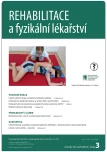Effect of cognitive decline on walking speed in older people
Authors:
Hereitová I. 1,2; Votík T. 1; Dorňák T. 2
Authors‘ workplace:
Fakulta zdravotnických studií, Západočeská univerzita v Plzni
1; Neurologická klinika, LF UP a FN Olomouc
2
Published in:
Rehabil. fyz. Lék., 30, 2023, No. 3, pp. 133-137.
Category:
Original Papers
doi:
https://doi.org/10.48095/ccrhfl2023133
Overview
Aim: The aim of the study is the association between walking speed and the results of the Montreal Cognitive Test (MoCA) in elderly people with cognitive decline compared to the control group. Methods: A total of 50 participants took part in the research, and were categorized using the MoCA into an experimental group consisting of 25 elderly people (69.6 ± 9.4) with cognitive decline (MoCA ≤ 25) and a control group with 25 cognitively intact elderlypeople (MoCA ≥ 26) at an average age of 59.5 ± 7.0 years. The Stroop Color and Word test, the Beck Depression Rating Scale (BDI-I), the standardized Short Falls Efficacy Scale International (Short FES-I) and the 36-Item Short Form Survey (SF-36) were used for the clinical examination. The participants were asked to perform a 10-metre walk test (10 MWT) in a randomized order in two conditions: 10 MWT at a self-selected constant speed, 10 MWT at a maximum gait speed. Results: According to the Mann-Whitney test, a statistically significant decrease in walking speed for 10 meters at a comfortable speed (P = 0.028 < 0.05) and for 10 meters at a maximum speed (P = 0.011 < 0.05) was demonstrated in the group with cognitive decline (MoCA ≤ 25) versus the cognitively intact control group (MoCA ≥ 26). Conclusion: Our study identified a significant decrease in comfortable and maximum walking speed during 10 MWT in older people with a cognitive decline.
Keywords:
dementia – mild cognitive impairment – walking speed
Sources
- Cova I, Markova A, Campini I et al. Worldwide trends in the prevalence of dementia. J Neurol Sci 2017; 379: 259–260. doi: 10.1016/j.jns.2017.06.030.
- Prince MJ, Wimo A, Guerchet M et al. World Alzheimer Report 2015. The global impact of dementia: an analysis of prevalence, incidence, cost and trends. [online]. Available from: https://www.researchgate.net/publication/281555306_World_Alzheimer_Report_2015_The_Global_Impact_of_Dementia_An_Analysis_of_Prevalence_Incidence_Cost_and_Trends.
- Petersen CR. Early diagnosis of Alzheimer´s disease: is MCI too late? Curr Alzheimer Res 2009; 6(4): 324–330. doi: 10.2174/156720509788929237.
- Grande G, Vanacore N, Vetrano DL et al. Free and cued selective reminding test predicts progression to Alzheimer‘s disease in people with mild cognitive impairment. Neurol Sci 2018; 39(11): 1867–1875. doi: 10.1007/s10072-018-3507-y.
- Winblad B, Amouyel P, Andrieu S et al. Defeating Alzheimer‘s disease and other dementias: a priority for European science and society. Lancet Neurol 2016; 15(5): 455–532. doi: 10.1016/S1474-4422(16)00062-4.
- Montero-Odasso M, Almeida QJ, Bherer L et al. Consensus on shared measures of mobility and cognition: from the Canadian Consortium on Neurodegeneration in Aging (CCNA). J Gerontol A Biol Sci Med Sci 2019; 74(6): 897–909. doi: 10.1093/gerona/gly148.
- Bloem BR, Gussekloo J, Lagaay AM et al. Idiopathic senile gait disorders are signs of subclinical disease. J Am Geriatr Soc 2000; 48(9): 1098–1101. doi: 10.1111/j.1532-5415.2000.tb04786.x.
- Montero-Odasso M, Schapira M, Soriano ER et al. Gait velocity as a single predictor of adverse events in healthy seniors aged 75 years and older. J Gerontol A Biol Sci Med Sci 2005; 60(10): 1304–1309. doi: 10.1093/gerona/60.10.1304.
- Verghese J, Robbins M, Holtzer R et al. Gait dysfunction in mild cognitive impairment syndromes. J Am Geriatr Soc 2008; 56(7): 1244–1251.doi: 10.1111/j.1532-5415.2008.01758.x.
- Kikkert LHJ, Vuillerme N, van Campen JP et al. Walking ability to predict future cognitive decline in old adults: a scoping review. Ageing Res Rev 2016; 27: 1–14. doi: 10.1016/j.arr.2016.02.001.
- Kueper JK, Speechley M, Lingum NR et al. Motor function and incident dementia: a systematic review and meta-analysis. Age Ageing 2017; 46(5): 729–738. doi: 10.1093/ageing/afx084.
- Barnes DE, Yaffe K. The projected effect of risk factor reduction on Alzheimer‘s disease prevalence. Lancet Neurol 2011; 10(9): 819–828. doi: 10.1016/S1474-4422(11)70072-2.
- Verghese J, Lipton RB, Hall CB et al. Abnormality of gait as a predictor of non-Alzheimer‘s dementia. N Engl J Med 2002; 347(22): 1761–1768. doi: 10.1056/NEJMoa020441.
- Montero-Odasso M, Verghese J, Beauchet O et al. Gait and cognition: a complementary approach to understanding brain function and the risk of falling. J Am Geriatr Soc 2012; 60(11): 2127–2136. doi: 10.1111/j.1532-5415.2012.04209.x.
- Verghese J, Annweiler C, Ayers E et al. Motoric cognitive risk syndrome: multicountry prevalence and dementia risk. Neurology 2014; 83(8): 718–726. doi: 10.1212/WNL.0000000000000717.
- Kelaiditi E, Cesari M, Canevelli M et al. Cognitive frailty: rational and definition from an (I.A.N.A./I.A.G.G.) international consensus group. J Nutr Health Aging 2013; 17(9): 726–734. doi: 10.1007/s12603-013-0367-2.
- Montero-Odasso M, Speechley M, Chertkow H et al. Donepezil for gait and falls in mild cognitive impairment: a randomized controlled trial. Eur J Neurol 2019; 26(4): 651–659. doi: 10.1111/ene.13872.
- Grande G, Triolo F, Nuara A et al. Measuring gait speed to better identify prodromal dementia. Exp Gerontol 2019; 124: 110625. doi: 10.1016/j.exger.2019.05.014.
- Abellan van Kan G, Rolland Y, Andrieu S et al. Gait speed at usual pace as a predictor of adverse outcomes in community-dwelling older people an International Academy on Nutrition and Aging (IANA) Task Force. J Nutr Health Aging 2009; 13(10): 881–889. doi: 10.1007/s12603-009-0246-z.
- Ferrucci L, Fabbri E. Inflammageing: chronic inflammation in ageing, cardiovascular disease, and frailty. Nat Rev Cardiol 2018; 15(9): 505–522. doi: 10.1038/s41569-018-0064-2.
- López-Otín C, Blasco MA, Partridge L et al. The hallmarks of aging. Cell 2013; 153(6): 1194–217. doi: 10.1016/j.cell.2013.05.039.
- Robertson DA, Savva GM, Kenny RA. Frailty and cognitive impairment – a review of the evidence and causal mechanisms. Ageing Res Rev 2013; 12(4): 840–851. doi: 10.1016/j.arr.2013.06.004.
Labels
Physiotherapist, university degree Rehabilitation Sports medicineArticle was published in
Rehabilitation and Physical Medicine

2023 Issue 3
Most read in this issue
- Functional examination and therapy in primary coccygeal syndrome
- The effect of minimalist footwear on the biomechanics of human gait
- Evaluation of upper extremity function after spinal cord injury using GRASSP
- Effect of cognitive decline on walking speed in older people
